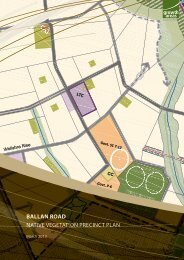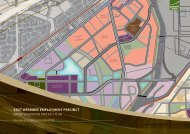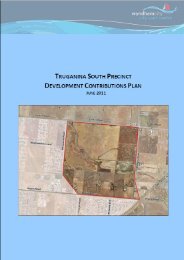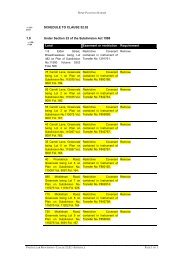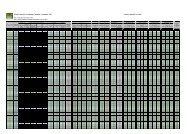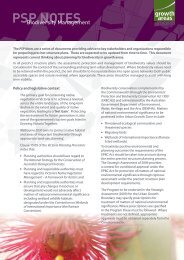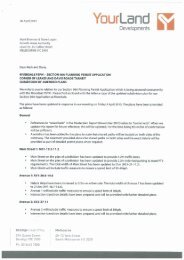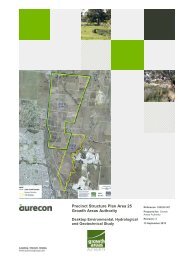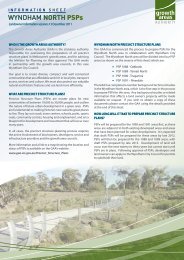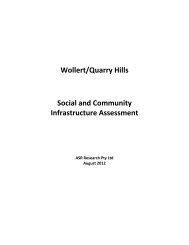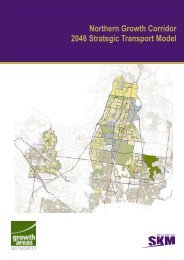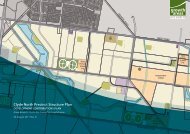Jobs Imbalance: Why We Must Plan To Create More Local Jobs
Jobs Imbalance: Why We Must Plan To Create More Local Jobs
Jobs Imbalance: Why We Must Plan To Create More Local Jobs
Create successful ePaper yourself
Turn your PDF publications into a flip-book with our unique Google optimized e-Paper software.
partners in creating new communities<br />
A forum of government planners and leading gures from Melbourne’s<br />
development industry has agreed on the need to address an imbalance<br />
between where people live and where they work.<br />
A roundtable convened by the GAA, heard that currently half of all<br />
Melbourne’s new population growth is going into the city’s ve outer<br />
urban growth areas – but only around 31 per cent of all new jobs growth<br />
is following suit.<br />
“Petrol pricing has doubled and as each year goes past, the distance<br />
traveled to employment has lengthened. <strong>We</strong> don’t want people traveling<br />
seven hours a week, if they can spend two and have the rest of the time<br />
playing with their kids,” <strong>Plan</strong>ning Minster Justin Madden said.<br />
GAA chief executive Peter Seamer says in 1961 around half of all<br />
Melburnians went to work via car but by 2006 that number had climbed<br />
to more than 80 percent.<br />
At the same time, the growth areas are home to 20 percent of the overall<br />
workforce but attract only 13 percent of all new jobs in Melbourne.<br />
ISSUE 5 : NOVEMBER 2008<br />
<strong>Jobs</strong> <strong>Imbalance</strong>: <strong>Why</strong> <strong>We</strong> <strong>Must</strong><br />
<strong>Plan</strong> <strong>To</strong> <strong>Create</strong> <strong>More</strong> <strong>Local</strong> <strong>Jobs</strong><br />
On average, Mr Seamer says Melbourne has an overall ratio of one job for<br />
every 1.1 worker. But in the growth areas there is only one job for every 1.6<br />
resident workers.<br />
“<strong>We</strong> have to try to get more of a one-to-one ratio between residents and<br />
local jobs. Then there will be the opportunity for people to work within<br />
their local community. But in the growth areas, which have tended to be<br />
seen as dormitory suburbs, there are more workers than jobs and that’s<br />
what we need to work on,” Mr Seamer said.<br />
Another issue is the type of jobs on offer in the growth areas. Overall<br />
Melbourne has a job mix of 74 percent ‘white-collar’ jobs and 26 percent<br />
‘blue-collar’.<br />
However the growth areas are weighted towards ‘blue-collar’ jobs with a<br />
mix of 62 percent ‘blue-collar’ jobs and 38 percent ‘white-collar’ jobs.<br />
“This has to change for a number of reasons including the cost of petrol<br />
and driving costs that have made employment travel nearly as costly as<br />
housing in some cases,” Mr Seamer said.
New Guidelines <strong>To</strong> <strong>Plan</strong> For <strong>Jobs</strong><br />
New strengthened draft Precinct Structure <strong>Plan</strong>ning Guidelines will<br />
address the jobs imbalance by embedding job targets into each PSP.<br />
The broad aim is to plan for one-job-per-household in a PSP with a 75:25<br />
split between ‘white’ and ‘blue-collar’ jobs.<br />
“<strong>We</strong> need to break down the city-centric focus of planning and the<br />
idea that some jobs can only be in the CBD”, said chief executive Peter<br />
Seamer.<br />
“This will mean we develop better, more thought-out major activity<br />
centres and create local employment clustered around small, local<br />
centres,” he said.<br />
“<strong>We</strong> need to design centres that are both practical today and meet the<br />
needs of future generations. <strong>We</strong> need to de-restrict planning zones<br />
to allow the widest range of land uses and review lot sizes and tenure<br />
patterns for activity centres,” Mr Seamer said.<br />
“<strong>We</strong> know, from work the GAA commissioned, that in the past<br />
Melburnians haven’t rated the location of their work highly when<br />
deciding where to live because the quality of life in the suburbs has been<br />
so attractive,” Mr Seamer said.<br />
“But as people battle the double-edged sword of needing affordable<br />
housing and local employment this will demand better planning<br />
solutions from all of us,” he said.<br />
<strong>Plan</strong>ning Minister Justin Madden launched the draft PSP guidelines at the<br />
GAA employment forum and is now inviting public comment.The new<br />
guidelines cover all land earmarked for development within Melbourne’s<br />
growth areas and in other broad-hectare locations. PSPs map out where<br />
everything from local schools to roads, open space, shopping centres,<br />
of ces and transport will go.<br />
The guidelines support the creation of the new Urban Growth Zone<br />
announced by the Premier in March and are part of a package of reforms<br />
to streamline the development process in the growth areas of Casey-<br />
Cardinia, Hume, Melton-Caroline Springs, Whittlesea and Wyndham.<br />
“They have a much stronger focus on employment and the need to plan<br />
for providing jobs in the growth areas,” Mr Seamer said.<br />
For the rst time planners will have to outline both the number and<br />
type of jobs forecast for new communities. There will also be a new<br />
requirement for planners to account for the distances new residents will<br />
have to travel to work.<br />
As well there’s a proposed ef ciency check to compare plans against key<br />
performance measures relating to land use, power and water use.<br />
The new draft guidelines also integrate native vegetation and cultural<br />
heritage management into the mainstream planning process.<br />
The guidelines also put a stronger focus on delivering high quality<br />
residential housing and more housing choice closer to transport.<br />
They implement Melbourne 2030 policy and the State Government’s<br />
objective of achieving minimum housing densities of 15 dwellings per<br />
hectare.<br />
As people battle the double-edged sword of needing<br />
affordable housing and local employment this will demand<br />
better planning solutions from all of us.<br />
Peter Seamer, CEO<br />
“Higher density housing around major shopping centres and<br />
transport is important because it allows people at all ages and stages<br />
to stay in their community,” Mr Seamer said.<br />
The guidelines also cover planning for public open space and the<br />
provision of community facilities.<br />
They propose that 10% of land in a PSP should be available for open<br />
space and should clearly be t for this purpose and that at least 6%<br />
of land should be available for active open space with shared use by<br />
sports groups and others.<br />
They also set out how schools, services and other infrastructure<br />
should be sequenced so residents know what to expect and when<br />
facilities will be ready, so community needs can be planned for and<br />
met.<br />
The revised guidelines have been developed in consultation with<br />
infrastructure authorities that will have greater input into the<br />
planning process far earlier in an effort to avoid bottlenecks and<br />
delays.<br />
The GAA says they will bring more certainty and clarity via a single<br />
process making suburb-scale planning quicker, more predictable<br />
and delivering high quality, diverse new communities tailored to the<br />
demands of their location.<br />
Copies of the draft guidelines can be downloaded from<br />
www.gaa.vic.gov.au.<br />
Submissions can be made to the GAA or if you wish to discuss these,<br />
contact Steve Dunn, GAA Director of Policy and Strategy on<br />
03 9651 9603.<br />
Comments can be emailed to pspguidelines@gaa.vic.gov.au.
partners in creating new communities<br />
WATERSHED 2008 - RESPONDING TO THE NEW DIMENSION TO HOUSING DEMAND<br />
Real Job Choices Close <strong>To</strong> Home<br />
GAA Chairman Chris Banks AM<br />
Since the end of the second world war in 1945,<br />
‘Housing Demand’ has been a dynamic force<br />
in uencing the growth, shape and structure of<br />
metropolitan areas encompassing our capital cities.<br />
In 2008 we are experiencing a convergence of<br />
in uences that create a new dimension to housing demand. But before<br />
we address this convergence it’s helpful to understand how housing<br />
demand has evolved during the last 60 years.<br />
From the 1950’s through the 1970’s housing demand focussed on<br />
‘shelter’ creating homes for rapidly growing families and an in ux of<br />
European migrants. Freeways and affordable production cars enabled<br />
us to escape the ‘industrial’ inner suburbs to the fresh and green eld<br />
garden suburbs where we could make a home for our growing young<br />
families.<br />
From the 1980’s through to the end of the century, as we started to<br />
mature as a society, the emphasis on the nuclear family was balanced<br />
by the in uence of a growing number of single person and two person<br />
households. And with women playing a larger role in the workforce<br />
‘time’ became a precious resource in family life. And so we saw housing<br />
demand change from an ‘obsession’ with house to a desire for place<br />
– hence a preparedness to compromise house for place in the home<br />
buying decision process. The gentri cation of our well serviced middle<br />
and inner suburbs gathered momentum and the ‘home improvement’<br />
industry was born.<br />
The 1990’s saw our capital cities reborn, as primarily adult only and<br />
smaller households saw the bene ts of living in or close to the city centre.<br />
The ‘apartment’ was now regarded as an acceptable permanent home,<br />
not just transient accommodation.<br />
Around the turn of the century the plaintive cry ‘save our suburbs’<br />
echoed through the leafy streets of our middle suburbs – a natural<br />
response to the unstoppable renaissance that was underway as we<br />
reshaped them to meet the demands of both demographic and lifestyle<br />
changes. Previously ‘dead’ shopping strips became urban villages and<br />
cafes spilled out onto the footpaths.<br />
Housing demand in Australia is in the process of undergoing its biggest<br />
upheaval since the 1950’s.<br />
The thesis of this paper is that the plethora of in uences now impacting<br />
on the lives of average Australians will result in them rethinking where<br />
and how they live.<br />
These in uences make it incumbent on all of us involved in the shaping<br />
and reshaping of our urban fabric – government and industry alike – to<br />
respond positively and decisively – to create urban places/environments<br />
where average Australians can both afford to buy or lease and in<br />
addition afford to live the life they want to live.<br />
This paper outlines the in uences impacting on our lives, suggest the<br />
marketplace response and propose action that can be taken now by<br />
government and industry, both separately and in partnership.<br />
Unique convergence of in uences impacting on our lives<br />
1. Population and household growth increasing<br />
• Record immigration levels driving growth<br />
• Melbourne growing at over 1,000 people per week<br />
• 45-50% of Melbourne’s increase going to Growth Areas<br />
2. Shape of households changing dramatically<br />
• Household size of 2.6, and decreasing<br />
• Major shift in community structure – with an equal number of:<br />
Families with Children - 28%<br />
Couples – pre, post or no children - 28%<br />
Single person households – 27%<br />
3. Slowing growth in household incomes<br />
• While at the same time costs are increasing – pressure on<br />
household budgets to stretch thinner<br />
4. Increased unemployment<br />
• 4.3% and likely to rise in the short term with global nancial<br />
uncertainty<br />
• Greater job uncertainty<br />
• Longer hours and working to older age<br />
5. Housing affordability worsening<br />
• Hits record lows, home lending declining<br />
• 1996: House price = 4 years annual salary<br />
• 2008: House price = 7½ years salary<br />
6. Energy costs increasing dramatically<br />
• Petrol price going up for foreseeable future<br />
• Equally for electricity and gas<br />
7. Water scarce and precious<br />
• Restrictions now a way of life<br />
• Community concern attuned to very high levels<br />
8. Cost of Living increasing<br />
• CPI above 3%<br />
• Affect of petrol prices felt in all aspects – food, clothing,<br />
entertainment<br />
9. Use of Public Transport exploding<br />
• Up ~30% over last 3 years<br />
• Result of petrol prices, congestion and community’s<br />
environmental sustainability consciousness<br />
10. Travel Times Increasing<br />
• Increased congestion and activity ‘dispersal’<br />
• Impact on energy consumption – affecting both individual and<br />
community cost<br />
11. Need for lifelong learning<br />
• May have up to 5 ‘careers’, with numerous job changes<br />
along the way<br />
• Continuous learning for career and personal development<br />
Continued on page 4...
WATERSHED 2008 - RESPONDING TO THE NEW DIMENSION TO HOUSING DEMAND<br />
Real Job Choices Close <strong>To</strong> Home<br />
...Continued from previous page<br />
Marketplace response<br />
The Australian consumer is intelligent and increasingly well informed. The<br />
global environmental and economic issues that were a decade ago seen<br />
by most as the responsibility of others – particularly government – are<br />
now recognised as things we as individuals can and should do something<br />
about.<br />
So the decision in relation to where we live will progressively and<br />
increasingly be linked to how we want to live.<br />
Finding a job close to home or a home close to job will become a<br />
paramount consideration.<br />
Easy access to public transport will of course be important to many, but<br />
ultimately the less time and distance required for home to work travel will<br />
become crucial.<br />
Although it could be said that this has always been a consideration what<br />
is clear now is that it will become paramount in our home buying and job<br />
selection decisions.<br />
Action to be taken now<br />
<strong>We</strong> must do things differently and do them now.<br />
1. <strong>Plan</strong>, design and accelerate the development of true multifunction<br />
activity centres in the growth areas.<br />
2. Melbourne is becoming a city of cities – the capital – city centre at the<br />
hub surrounded by what we could call edge or network cities, linked to<br />
the centre but providing all the services needed for living. So ‘out there’<br />
at Pakenham becomes ‘here’ to those who live, learn, work and play in its<br />
environs.<br />
3. Work with <strong>Local</strong> Government to market their ‘city’ to prospective<br />
tertiary employers – here and overseas.<br />
4. Provide incentives/assistance to employers to create tertiary employment<br />
in the edge cities – led by State Government moving jobs to our edge<br />
cities.<br />
The concept of ‘live, learn, work, play’ communities has for some time<br />
been recognised and appreciated as a desirable objective for green eld<br />
urban development and the redevelopment of our established urban<br />
areas.<br />
‘Dormitory’ suburbs and car dependent Business Parks as created in the<br />
sixties and seventies are and must be a thing of the past – ‘Dinosaurs’ of<br />
development.<br />
‘Live, learn, work, play’ urban environments are now an absolute necessity.<br />
But they won’t happen without a close partnership between the three<br />
spheres of government and the private sector.<br />
Now more than ever before we must stand up and be counted in<br />
initiating action that will make greater Melbourne a truly world class, 21st<br />
century city, where our people can not only afford housing, but in addition<br />
afford to live the lives they want to live.<br />
This is an edited speech given to the GAA ‘Better employment choices in Melbourne’s<br />
Growth Areas’ roundtable held on 14th October 2008<br />
EMPLOYMENT FAST FACTS<br />
GAs have 20% of Melbourne’s current workforce<br />
But only 13% of Melbourne’s jobs are located in<br />
GAs<br />
GAs accommodating 50% of Melbourne’s population<br />
growth<br />
But only attracting 31% of new jobs<br />
Melbourne has an overall rate of 1 job for every 1.1<br />
worker<br />
But GAs only have 1 job in their area for every 1.6<br />
workers<br />
Melbourne has job mix of 74% ‘White Collar’ / 26%<br />
‘Blue Collar’<br />
But GAs are weighted towards ‘Blue Collar’ with<br />
mix 62% ‘White’ / 38% ‘Blue’<br />
New GA workers primarily ‘White Collar’ at 68%<br />
But below Melbourne (74%) and, jobs in their LGAs<br />
biased away from ‘White Collar’ at only 62%
New Mapping Work to Streamline<br />
<strong>Plan</strong>ning<br />
A new project to map native ora and fauna in Melbourne’s growth areas<br />
is underway so native vegetation can be protected or offset in future<br />
development.<br />
The project is being funded as part of the $3.5 million allocated by the<br />
Brumby Government to streamline planning processes in Melbourne’s<br />
Growth Areas over the next two years.<br />
GAA Chief Executive Peter Seamer says the mapping will help protect<br />
the environmental assets for future generations and also fast-track the<br />
development process by up to a year.<br />
In the past, native vegetation has often been considered as a separate<br />
issue for every housing or industrial subdivision proposal, often causing<br />
delay and an uncoordinated approach to the protection of native<br />
vegetation.<br />
“After the mapping, we will be able to consider the native vegetation<br />
issues at an ecosystem level, and get better outcomes for the environment<br />
and the community,” Mr Seamer said.<br />
The project envisages mapping a total of up to 25,000 hectares mainly in<br />
areas that haven’t been looked at before and this information will help the<br />
GAA and Councils to plan new communities by making assessments of<br />
native vegetation at a much wider scale.<br />
“What we learn about native vegetation will inform the master planning<br />
of new communities by identifying potential reserve areas, biodiversity<br />
corridors and areas with potential to provide offsets for vegetation lost as a<br />
result of urban development,” Mr Seamer said.<br />
The survey will take place across the growth areas within the Urban<br />
Growth Boundary (UGB) and in neighbouring areas outside the UGB<br />
where there is a high value habitat.<br />
“In some cases we need to look outside the Urban Growth Boundary<br />
because ecosystems don’t necessarily stop at planning boundaries,” Mr<br />
Seamer said.<br />
“This is important information that Victorians need so that we design<br />
our new neighbourhoods while protecting the value of plants, trees and<br />
animal habitat,” he said.<br />
“Then we can make strategic planning decisions about planning for<br />
new urban communities well ahead of residential and employment<br />
development.”<br />
<strong>To</strong> nd out more information about the survey, contact one of the<br />
following GAA team members: Steve Dunn, Bill Vasiliadis or Scott<br />
Waterhouse on 9651 9625.<br />
Cardinia a Stand-Out<br />
Cardinia Shire has been awarded a planning excellence award from the<br />
<strong>Plan</strong>ning Institute of Australia for its Cardinia Road Precinct Structure <strong>Plan</strong><br />
and Development Contributions <strong>Plan</strong>.<br />
The judges were impressed by the council of cers’ commitment to<br />
sustainability, their exible approach and the plan’s protection of<br />
Dandenong Ranges foothills and the endangered growling grass frog.<br />
The PSP was approved by the Minister in November 2008.<br />
Melton Shire Council has endorsed three Precinct Structure <strong>Plan</strong>s at<br />
Taylors Hill <strong>We</strong>st, Melton <strong>To</strong>wnship North and <strong>To</strong>olern. The GAA has<br />
facilitated the preparation of the plans and will contribute $100,000<br />
towards the cost of nalising the strategic planning work.<br />
<strong>To</strong>olern spans 2,500 hectares and is one of the biggest growth precincts<br />
in Melbourne. It will transform Melton into a major urban centre for the<br />
west, with a new activity centre, railway station and local jobs.<br />
The Taylors Hill <strong>We</strong>st precinct, west of Caroline Springs, involves<br />
250 hectares of land and is being planned as a self-contained<br />
neighbourhood. Melton <strong>To</strong>wnship North covers 100 hectares and<br />
contains new residential and commercial development catering for new<br />
residents as well as those in nearby Melton.<br />
Newly Appointed GAA Board<br />
Members<br />
An architect specialising in urban design with more than 25 years in<br />
private practice has been appointed to the Growth Areas Authority<br />
Board.<br />
Ann Keddie is also a sessional member of the Victorian Civil and<br />
Administrative Tribunal and a member of the Priority Development Panel.<br />
She’s also a longstanding member of the Royal Australian Institute<br />
of Architects and the Victorian <strong>Plan</strong>ning and Environmental Law<br />
Association.<br />
She is joined on the Board by another new appointee, Ian Munro PSM,<br />
a former CEO of Invest Assist and a member of the Property Council of<br />
Australia.<br />
A former deputy secretary to the Department of Innovation, Industry and<br />
Regional Development (DIIRD), Ian Munro began his professional life as a<br />
licensed surveyor before working in major project facilitation for the State<br />
Government.<br />
Whittlesea First Past The Post<br />
The City of Whittlesea has been praised by the State Government for<br />
becoming the rst of the ve growth area councils to complete its<br />
precinct structure planning.<br />
The milestone was achieved with the approval of the Epping North East<br />
Structure <strong>Plan</strong> that will provide for 4,500 new homes while protecting<br />
local Redgum woodlands and threatened grasslands.
<strong>We</strong>’re broadly on track to approve land<br />
for an additional 90,000 homes by 2012<br />
and cut a year out of the planning approval process<br />
Peter Seamer, CEO<br />
Easing the Pressure on New House Prices<br />
Melbourne now has double the annual supply of housing lots in its growth hot-spots as a result of recent planning reforms.<br />
Growth Areas Authority chief executive of cer, Peter Seamer, says in the last year the pipeline of new housing lots in the ve growth areas has almost<br />
doubled, helping maintain Melbourne’s competitive advantage as an affordable place to live. Work by the GAA and Councils, together with the creation<br />
of a new Urban Growth Zone, has brought more land to market much earlier.<br />
“Duplication in the old labyrinthine planning system has been removed and this is lowering developer’s costs and bringing more competition to the new<br />
housing market,” Peter Seamer said.<br />
The number of new lots zoned for housing in the growth areas in the last 12 months is 18,911 – which is nearly two years’ of the average consumption<br />
of land for housing. Prior to the planning reforms, often less than 10,000 lots a year were improved.<br />
“<strong>We</strong>’re broadly on track to approve land for an additional 90,000 homes by 2012 and cut a year out of the planning approval process,” Mr Seamer said.<br />
CONTACT US<br />
The Growth Areas Authority<br />
Level 6, 35 Spring Street, Melbourne, Victoria, 3000<br />
Phone: (03) 9651 9600, Fax: (03) 9651 9623<br />
Email: info@gaa.vic.gov.au<br />
<strong>We</strong>bsite: www.gaa.vic.gov.au<br />
Printed with vegetable-based inks, using an alcohol-free process,<br />
on Australian Made 100% Recycled Paper<br />
The Growth Areas Authority is always interested in your<br />
views about our programs and initiatives, and the issues<br />
covered in this newsletter.<br />
If you would you like to receive regular email updates on<br />
the work of the Growth Areas Authority, please register<br />
via our website www.gaa.vic.gov.au<br />
This publication may be of assistance to you but the Growth<br />
Areas Authority and its employees do not guarantee that<br />
the publication is without aw of any kind or is wholly<br />
appropriate for your particular purposes and therefore<br />
disclaims all liability for any error, loss or other consequence<br />
which may arise from you relying on any information in this<br />
publication.




